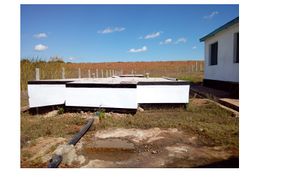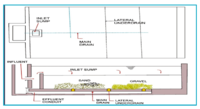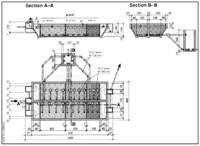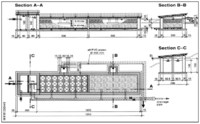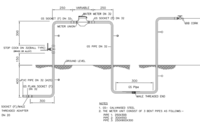Tanzania Ministry of Water Design Manual 4th Edition
Contents
- 1 VOLUME I: DESIGN OF WATER SUPPLY PROJECTS
- 1.1 Chapter 1: Introduction
- 1.2 Genesis/Background
- 1.3 Rationale
- 1.4 Organisation/description of the manual
- 1.5 ESIA and EIA Compliance
- 1.6 Water supply
- 1.7 Design of Infrastructure: intakes, rising main pipelines, break pressure tanks, washout & air release values, various different valves, storage tanks, distribution pipelines, water points & soak pits
- 2 Appendix: Drawings
- 3 References
VOLUME I: DESIGN OF WATER SUPPLY PROJECTS
Chapter 1: Introduction
The preparation of this DCOM manual has been preceded by an overview of four important global consideration of Water Supply and Sanitation prior to reviewing the water and sanitation sector in Tanzania. It is followed by an explanation of the rationale for the preparation of the 4th edition. The introductory chapter is concluded by presenting the organization of the manual as well as the purpose and content of this volume of the DCOM.
Global Considerations on Water Supply and Sanitation
Sustainable Development Goals (SDGs)
In 2015, world leaders came together at the United Nations in New York and adopted the 2030 Agenda for Sustainable Development. Governments responded to the common development challenges they faced and the changing world around them by uniting behind a truly forward-looking, yet urgent plan to end poverty and create shared prosperity in a healthy and peaceful planet. The Agenda 2030 central principle is leaving no one behind in achieving the 17 Sustainable Development Goals (SDGs) through 169 targets. The 2030 Agenda for Sustainable Development adopted at the UN Summit includes the SDG 6 on Water and Sanitation and in December 2016, the United Nations General Assembly unanimously adopted the resolution “International Decade for Action - Water for Sustainable Development” (2018–2028) in support of the achievement of SDG 6 on water and sanitation and the related targets [1]. It should also be noted that, water and sanitation are at the heart of the Paris Agreement on climate change 2015 (https://unfccc.int/process-and-meetings/the-paris-agreement/the-paris-agreement).
Ensuring availability and sustainable management of water and sanitation for all has therefore been for a long while an important topic at the United Nations and is now turning this vision into a reality, through national leadership and global partnerships. Water and sanitation are at the core of sustainable development and the range of services they provide, underpin poverty reduction, economic growth and environmental sustainability. The world needs now to transform the way it manages its water resources and the way it delivers water and sanitation services for billions of people (https://sustainabledevelopment.un.org/sdg6).
Therefore, the designers and engineers have the responsibility to support the Government to achieve the SDG 6, where population growth and rapid urbanization have intensified demand for water and sanitation services beyond all past thresholds.
The existing design manual for water supply [2] and wastewater disposal (3rdedition) was formally adopted by the Ministry that was responsible for Water in 2009 and it consists of three parts namely; volume I on Water supply, volume II on Wastewater disposal and volume III on Water pipelines standards and specifications. Since it is now nearly ten years since the third edition of the design manual was adopted and in the meantime, many scientific and technological changes have taken place including the conclusion of MDGs and adoption of the SDGs in 2015 as well as learning some useful lessons out of implementation of the WSDP I and WSDP II (which is still ongoing); it is felt it is high time to revise the design manual [3]
manual.
Genesis/Background
The existing design manual for water supply and wastewater disposal (3rdedition) was formally adopted by the Ministry that was responsible for Water in 2009 and it consists of three parts namely; volume I on Water supply, volume II on Wastewater disposal and volume III on Water pipelines standards and specifications. Since it is now nearly ten years since the third edition of the design manual was adopted and in the meantime, many scientific and technological changes have taken place including the conclusion of MDGs and adoption of the SDGs in 2015 as well as learning some useful lessons out of implementation of the WSDP I and WSDP II (which is still ongoing); it is felt it is high time to revise the design manual.
Rationale
The existing design manual for water supply and wastewater disposal (3rdedition) was formally adopted by the Ministry that was responsible for Water in 2009 and it consists of three parts namely; volume I on Water supply, volume II on Wastewater disposal and volume III on Water pipelines standards and specifications. Since it is now nearly ten years since the third edition of the design manual was adopted and in the meantime, many scientific and technological changes have taken place including the conclusion of MDGs and adoption of the SDGs in 2015 as well as learning some useful lessons out of implementation of the WSDP I and WSDP II (which is still ongoing); it is felt it is high time to revise the design manual.
Organisation/description of the manual
The existing design manual for water supply and wastewater disposal (3rdedition) was formally adopted by the Ministry that was responsible for Water in 2009 and it consists of three parts namely; volume I on Water supply, volume II on Wastewater disposal and volume III on Water pipelines standards and specifications. Since it is now nearly ten years since the third edition of the design manual was adopted and in the meantime, many scientific and technological changes have taken place including the conclusion of MDGs and adoption of the SDGs in 2015 as well as learning some useful lessons out of implementation of the WSDP I and WSDP II (which is still ongoing); it is felt it is high time to revise the design manual.
ESIA and EIA Compliance
The existing design manual for water supply and wastewater disposal (3rdedition) was formally adopted by the Ministry that was responsible for Water in 2009 and it consists of three parts namely; volume I on Water supply, volume II on Wastewater disposal and volume III on Water pipelines standards and specifications. Since it is now nearly ten years since the third edition of the design manual was adopted and in the meantime, many scientific and technological changes have taken place including the conclusion of MDGs and adoption of the SDGs in 2015 as well as learning some useful lessons out of implementation of the WSDP I and WSDP II (which is still ongoing); it is felt it is high time to revise the design manual.
Water supply
The existing design manual for water supply and wastewater disposal (3rdedition) was formally adopted by the Ministry that was responsible for Water in 2009 and it consists of three parts namely; volume I on Water supply, volume II on Wastewater disposal and volume III on Water pipelines standards and specifications. Since it is now nearly ten years since the third edition of the design manual was adopted and in the meantime, many scientific and technological changes have taken place including the conclusion of MDGs and adoption of the SDGs in 2015 as well as learning some useful lessons out of implementation of the WSDP I and WSDP II (which is still ongoing); it is felt it is high time to revise the design manual.
Design of Infrastructure: intakes, rising main pipelines, break pressure tanks, washout & air release values, various different valves, storage tanks, distribution pipelines, water points & soak pits
Design of water supply networks
Types of networks (e.g. grid, loops, etc.)
Design methodologies
Transmission main
Distribution network
Storage tanks
Units costs
Gravity schemes
Pumping systems
Appendix: Drawings
List of drawings organized per category:
Appendix I: Water Treatment
This section presents various drawings related to Water Treatment
Appendix 2: House Water Connections Models
This section presents various drawings related to House Water Connections Models
Appendix 3: Structural Drawings
This section presents various structural drawings
References
- ↑ UN (2020). Helping governments and stakeholders make the SDGs a reality. https://sustainabledevelopment.un.org/
- ↑ URT (2016). The Second Five Year Development Plan (FYDP II), 2016/17 – 2020/21. Ministry of Finance and Planning. https://mof.go.tz/mofdocs/msemaji/Five%202016_17_2020_21.pdf.
- ↑ URT (2017). National Guidelines for Water, Sanitation and Hygiene in Health Care Facilities. Ministry of Health, Community Development, Gender, Elderly and Children (MoHCDGEC).
